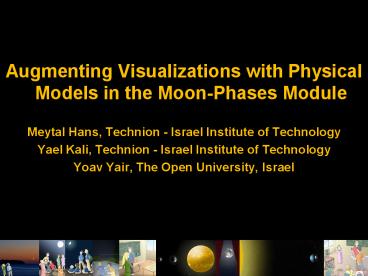Augmenting Visualizations with Physical Models in the MoonPhases Module - PowerPoint PPT Presentation
Title:
Augmenting Visualizations with Physical Models in the MoonPhases Module
Description:
Yael Kali, Technion - Israel Institute of Technology. Yoav Yair, The Open University, Israel ... Sadler & Shapiro, 1993; Gazit, Yair & Chen, 2005; Trumper, 2006) ... – PowerPoint PPT presentation
Number of Views:47
Avg rating:3.0/5.0
Title: Augmenting Visualizations with Physical Models in the MoonPhases Module
1
- Augmenting Visualizations with Physical Models in
the Moon-Phases Module - Meytal Hans, Technion - Israel Institute of
Technology - Yael Kali, Technion - Israel Institute of
Technology - Yoav Yair, The Open University, Israel
2
Research Rationale
- Students have difficulties in understanding the
moon phases because - Requires spatial abilities
- Large scale dynamic phenomenon
- Involves understanding the phenomenon from
multiple perspectives (frames of reference)
(e.g. Mulholland Ginns, 2007 Nussbaum
Novak, 1976 Callison and Wright , 1993) - Visualizations and physical models can each
support learning(e.g. Hansen et al., 2004
Coyle, Gregory, Luzader, Sadler Shapiro, 1993
Gazit, Yair Chen, 2005 Trumper, 2006)
3
What do we mean by understanding the moon
phases?
Relating multiple perspectives External view
(from space) and internal view (from earth -
geocentric)
4
Visualization and the physical model in the WISE
moon-phases
5
Goals
- To examine the effect of the Moon Phases module
on - Students ability to solve problems regarding the
moon phases - Students ability to solve general spatial
ability problems that require - relating between different frames of reference
- Mental rotation (Purdue test)
To explore how students develop their
understanding of the moon phases and their
spatial abilities
To explore how students develop their
understanding of the moon phases and spatial
abilities in this context.
6
Quantitative findings Pre-Post comparisons whole
sample (N202)
7
Quantitative findings Sub-samples
Schools (7th-8th) (N114)
Space club (7th-8th) (N65)
College (N 14)
Basic knowledge
Moon phases
Sun-rise and sun-set
Spatial test 1
Spatial test 2
Basic knowledge
Moon phases
Sun-rise and sun-set
Spatial test 1
Spatial test 2
Basic knowledge
Moon phases
Sun-rise and sun-set
Spatial test 1
Spatial test 2
8
Stages in the development of understanding of the
moon-phases
- Aha points
- 1 - Internal (geocentric) view
- 2 Awareness of difference internal / external
views. - 3 Relating internal / external views
- 4 Adding relative movement (moon-rise and
moon-set)
9
Learning paths of case-study students (6 pairs)
Relative Movement
Relating internal / external
Awareness internal / external
Internal view
10
Critical factors in learning (reaching aha
points) from the visualization
- Back and forth transitions between visualization
(external view) and physical model (internal
view) - Negotiation of understanding between students
- Guidance
- Scaffolding guiding questions in module
- Teacher as guide































